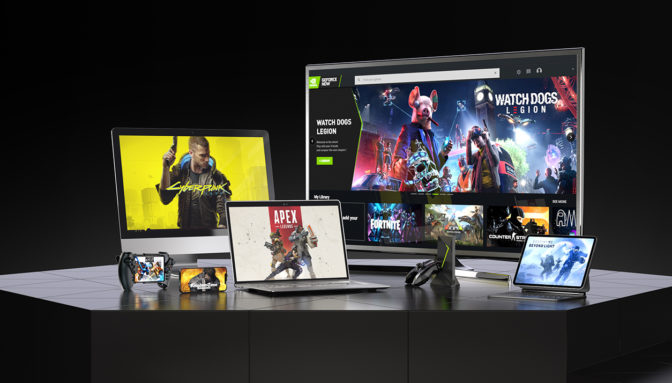
Through clever AI techniques, Nvidia has ingeniously outsmarted the conventional game rendering pipeline, resulting in a significant enhancement of traditionally underpowered laptops.
Nvidia’s latest RTX 40-series mobile GPUs, especially when considering options like the RTX 4090 in devices such as the Asus Strix Scar 17, exhibit formidable power. However, the true game-changer lies in the lower-end models. It’s not merely about raw computational muscle; rather, it’s about the introduction of Deep Learning Super Sampling (DLSS), Nvidia’s AI-driven technology for upscaling and generating frames.
This revelation became evident during Microsoft’s Surface event, where they unveiled the Surface Laptop Studio 2. While exploring the demo area, I observed a Microsoft representative immersed in a game of Cyberpunk 2077, and it looked astonishingly good. The gameplay was smooth and consistent, and one could even dare to assume that ray tracing was enabled. Although I couldn’t confirm the ray tracing status, the game’s visuals were undeniably impressive. I entertained the idea that this experience was powered by cloud gaming, as even the top-of-the-line RTX 4060 GPU in the Surface Laptop Studio 2 might not seem potent enough. To my surprise, the representative clarified that it was running locally.
Reflecting on events two years ago when Microsoft first introduced the original Surface Laptop Studio, I pondered its potential as a genuine gaming laptop for Microsoft. At that time, my argument revolved mainly around its possession of a dedicated GPU—a rarity in such laptops back then—and the available cloud ecosystem through Xbox Game Pass.
In hindsight, those concerns seem quaint now. Back then, I questioned whether the RTX 3050 Ti with its mere 4GB of VRAM would suffice. Today, I’d describe it as inadequate. The initial idea was to utilize the underpowered GPU for less demanding games locally and rely on streaming for heavyweight titles like Cyberpunk 2077. How times have changed.
In just two years and a single GPU and laptop generation later, the transformation is striking. The original Surface Laptop Studio could barely handle games, requiring resolution reductions, medium presets, and tolerance for frame drops. Now, the Surface Laptop Studio 2 effortlessly runs Cyberpunk 2077, one of the most demanding PC games, at what seemed like high settings with smooth frame rates.
Credit for this transformation goes to Nvidia and its relentless pursuit of optimizations in the rendering pipeline. DLSS started as a shaky concept but evolved into the standard for upscaling technology. It then advanced to DLSS Frame Generation, and now we even have Ray Reconstruction via DLSS 3.5. All of these features are available on the Surface Laptop Studio 2 and other laptops with RTX 40-series GPUs.
While these features are certainly advantageous for high-end GPUs, they prove to be game-changers for devices like the Surface Laptop Studio 2. Specifically, Frame Generation through DLSS 3 significantly alters the gaming experience. It inserts a frame between each rendered frame in supported games, such as Cyberpunk 2077. This effectively doubles the frame rate; if you were playing a game at 30 frames per second (fps), it would appear as 60 fps. There’s some overhead, but it’s a minor inconvenience when paired with DLSS Super Resolution.
This approach could be seen as a form of “cheating” because it allows weaker GPUs to appear significantly faster than their actual capabilities. However, it’s crucial to emphasize that this isn’t a negative connotation of cheating; rather, it’s a testament to Nvidia’s ingenuity. It required substantial effort on Nvidia’s part to make Frame Generation work effectively. It represents a way for Nvidia to optimize the rendering pipeline, relying on sophisticated AI technology instead of sheer computational horsepower, and this greatly benefits traditionally underpowered laptops.
Nevertheless, DLSS 3.5 isn’t without its flaws. I’ve previously discussed my reservations about DLSS Frame Generation, and if you have a powerful desktop PC, you might opt to disable it. However, when the alternative is cloud gaming, a common scenario for many non-gaming laptops, DLSS Frame Generation becomes a much more appealing option.
Laptops, in particular, reap the rewards of this technology, as they are typically not upgradeable (except for machines like the Framework laptop). As hardware ages and demanding games emerge, one can hope that they will also come with Frame Generation, extending the lifespan of these devices beyond their raw hardware capabilities.
I’ve noticed a growing trend of low-end gaming laptops and creator-focused machines equipped with RTX 4050 or RTX 4060 GPUs. These GPUs were originally designed for accelerating professional tasks and casual gaming, such as playing Civilization VI during brief moments of free time. However, with the introduction of DLSS Frame Generation, they now offer playable frame rates even in the most demanding games.
In essence, Nvidia is employing DLSS Frame Generation as a form of “cheating,” but it’s a type of cheating that empowers laptops that were previously unsuitable for gaming to deliver significantly enhanced performance.
